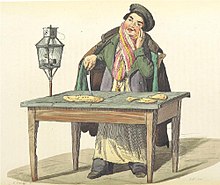Pizza Margherita

Pizza Margherita (more commonly known in English as Margherita pizza) is a typical Neapolitan pizza, made with San Marzano tomatoes, mozzarella cheese, fresh basil, salt, and extra-virgin olive oil.
Origin and history[]

A widespread belief says that in June 1889 the pizzaiolo Raffaele Esposito, Pizzeria Brandi's chef, invented a dish called "Pizza Margherita" in honor of the Queen of Italy, Margherita of Savoy, and the Italian unification, since toppings are tomato (red), mozzarella (white) and basil (green), ingredients inspired by the colors of the national flag of Italy.[1]
While the name Pizza Margherita may have been popularized because of the Queen's visit, a pizza made with the same toppings was already present in Naples between 1796 and 1810.[2] In 1830, in the book Napoli, contorni e dintorni, written by Riccio, it was described as a pizza with tomato, mozzarella and basil.[3] In 1849 Emanuele Rocco recorded different pizza toppings like basil, tomatoes and thin slices of mozzarella;[4] the mozzarella was thinly sliced, and arranged with a flower-shape over the tomato sauce, along with the basil leaves: this may be the real origin of the name Margherita (meaning daisy).[5]
In 1866, Francesco De Bourcard, writing about the Naples traditions,[4] described the most commonly used pizza toppings at that time, included the ones called today pizza marinara and pizza margherita, as well as the possible origin of calzone:
The most ordinary pizzas, called coll'aglio e l'olio (with garlic and oil), are dressed with oil, and over there it's spread, as well as salt, the origanum and garlic cloves shredded minutely. Others are covered with grated cheese and dressed with lard, and then they put over a few leaves of basil. Over the firsts is often added some small seafish; on the seconds some thin slices of mozzarella. Sometimes they use slices of prosciutto, tomato, arselle, etc.... Sometimes folding the dough over itself it forms what is called calzone.[4]
See also[]
References[]
- ^ Arturo Iengo (2008). Cucina Napoletana: 100 Recipes from Italy's Most Vibrant City. New Holland Publishers. p. 126. ISBN 978-1-84537-989-6. Archived from the original on 2018-06-16. Retrieved 2017-12-12.
- ^ Angelo Forgione (2013). Made in Naples. Magenes. p. 195. ISBN 978-88-6649-039-5.
- ^ "120 anni della pizza". La Repubblica.
- ^ a b c Francesco De Bourcard (1866). Usi e costumi di Napoli e contorni descritti e dipinti. Vol. 2. p. 124.
- ^ Angelo Forgione (2013). Made in Naples. Magenes. p. 194. ISBN 978-88-6649-039-5.
Sources[]
- Francesco, De Bourcard (1866). Usi e costumi di Napoli e contorni descritti e dipinti. Naples.
![]() Media related to Pizza Margherita at Wikimedia Commons
Media related to Pizza Margherita at Wikimedia Commons
- Pizza varieties
